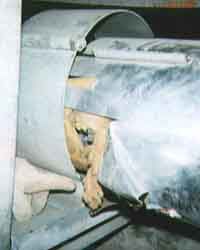| Photo 2-20. Damaged Pipe Guide (C-700)
2-20. 8” spider* pulled out of sleeve shows evidence of catching on the bottom side of the sleeve when the pipe cooled and tried to contract back in. (The finger points to an indentation in the sleeve). When the spider’s* wing caught on the sleeve, the pipe slipped through the clamped spider guide pushing it back into the metal jacket and insulation beneath.
This is a guide for EJ-36 which has a 16” travel on each side. Yet the guide is only 8”—not in accordance with the Engineers specifications as noted in Photo 1-11. Spreadsheet “ Failures
” calculates that the north side of EJ-36 will extend over 10”-thus very possibly pushing 8” spiders out of their guide sleeves. (See footnote below for a discussion of why guides are critical to prevent expansion joint failure.)
* The “spider” is the internal portion of a guide which bolts via clamps to the pipe. The “wings” of the spider then travel inside the guide’s sleeve which is welded to a support.
|


